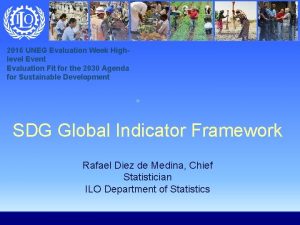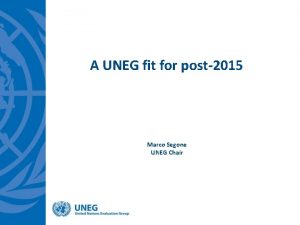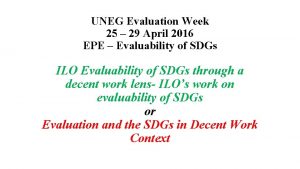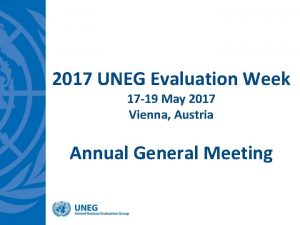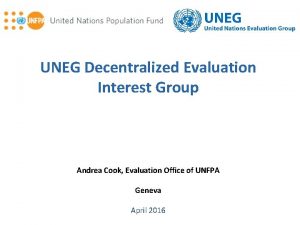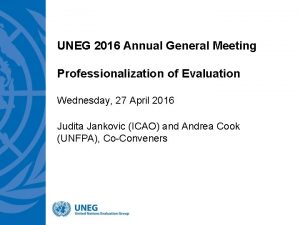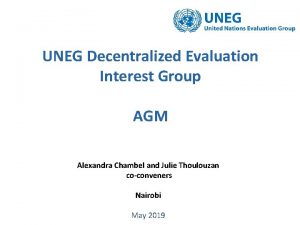2016 UNEG Evaluation Week Highlevel Event Evaluation Fit















- Slides: 15

2016 UNEG Evaluation Week Highlevel Event Evaluation Fit for the 2030 Agenda for Sustainable Development SDG Global Indicator Framework Rafael Diez de Medina, Chief Statistician ILO Department of Statistics

Introduction • Agreement on a global indicator framework for monitoring progress towards achieving SDGs reached on 11 March 2016 • Framework proposed by the Inter-Agency and Expert Group on SDG indicators (IAEG-SDGs) to the UN Statistical Commission, hosted by the Statistics Division of the UNDESA • Needs to be adopted by the Economic and Social Council (ECOSOC) in June 2 2016 and the General Assembly in

IAEG-SDGs • The IAEG-SDGs was tasked to develop an indicator framework for the SDGs at the global level, and to support its implementation • Composed of member States and includes regional and international agencies and civil society as observers • Annual report on progress towards the goals and targets at the global level (then regional and national) • Regularly review capacity-building activities in statistical areas 3

Features • Evidence-based, emphasis on statistical data • Focus on national ownership as data will be produced by national statistical systems • Importance of data disaggregation by income, gender, age, race, ethnicity, migratory status, disability, geographic location and other characteristics relevant in national contexts • Indicators do not necessarily cover all aspects of goals and targets • Data for several of the targets remains unavailable • Targets not always quantified 4

Different indicators The indicators are classified into three tiers: • Tier I: an established methodology exists and data are already widely available • Tier II: a methodology has been established but for which data are not easily available for all regions • Tier III: an internationally agreed methodology has not yet been developed or it is not widely accepted or discussed and scarce info is available 5

Indicators Framework The agreed Framework consists on: Goal 1 Goal 2 Goal 3 Goal 4 Goal 5 Goal 6 Goal 7 Goal 8 Goal 9 Goal 10 Goal 11 Goal 12 Goal 13 Goal 14 Goal 15 Goal 16 Goal 17 ILO Department of Statistics Tier III UD. /Comb. Total 3 4 4 1 12 7 2 5 0 14 15 7 3 1 26 3 4 2 2 11 3 4 6 1 14 6 0 5 0 11 4 0 2 0 6 1 0 17 8 1 3 0 12 4 0 5 2 11 2 7 6 0 15 1 3 8 1 13 0 2 4 1 7 2 0 8 0 10 6 1 5 2 14 9 7 6 1 23 15 2 5 3 25 98 50 78 15 241 6

Further refinements Calendar for revisión/review of indicators: 2017: specific proposals for refinements at the 47 th. UNSC based on Tiers and new methodologies. 2017: A work plan for the review will be presented envisaging: - 1 st. Review of proposed refinements in 2020 - 2 nd. Review of proposed refinements in 2025 ILO Department of Statistics 7

Monitoring and Reporting • National, regional and global level • High-level political forum (HLPF) has been formed, which will be informed by an annual progress report on the SDGs prepared in cooperation with the UN system, based on the global indicator framework • The forum will have the central role in overseeing follow-up and review (NSOs are the members) • It will also conduct national reviews starting with 22 in July 2016, which are voluntary and driven by countries • Regional commissions to contribute to the 8 regional reviews

Global and national monitoring ILO Department of Statistics 9

Essential for Monitoring and Reporting • Quality, accessible, timely and reliable disaggregated data will be needed to help with the measurement of progress and to ensure that no one is left behind • Baseline data for several of the targets remains unavailable, which is essential for monitoring • Need for increased support for strengthening data collection and capacity -building in member States • Need to address this gap in data 10

Baselines • Baselines should be based on best-practices and agreed baseline methodologies • Determination of baselines can follow different approaches: –Multi-indicator or indicator-specific baselines –Global, regional or national baselines –Baselines for specific sub-population groups • Baseline setting needs to be consistent with the purpose of trend analysis, e. g. : –Explore evolution over time of a single indicator a country –Provide a global picture all indicators across many countries ILO Department of Statistics 11

Which baseline? • The MDGs were adopted in 2000 with an end date of 2015. • The baseline year for global tracking of MDG indicators was established as 1990 in order to allow for comparing trends before and after the adoption of the MDGs • The 2030 Agenda makes no specific reference to a baseline year(s) for global tracking • IAEG to decide on baseline selection ILO Department of Statistics 12

Baselines (II) • 2 Mentions of baselines in “Transforming our world: the 2030 Agenda for Sustainable Development” - Para 57: “ We recognize that baseline data for several of the targets remains unavailable, and we call for increased support for strengthening data collection and capacity building in Member States, to develop national and global baselines where they do not yet exist. ” - Para 75: “The Goals and targets will be followed up and reviewed using a set of global indicators. These will be complemented by indicators at the regional and national levels which will be developed by Member States, in addition to the outcomes of work undertaken for the development of the baselines for those targets where national and global baseline data does not yet exist. ” ILO Department of Statistics 13

Some implications • UNDAFs work at national levels • Filling the huge data gaps • Capacity building in Member states and constituents • Resources constraints: Global Partnerships, Data revolution, National budgets ILO Department of Statistics 14

Target and indicators on Data Goal Target Indicator Goal 17. Strengthen the means of implementat ion and revitalize the Global Partnership for Sustainable Developme nt 17. 18 By 2020, enhance capacity-building support to developing countries, including for least developed countries and small island developing States, to increase significantly the availability of high-quality, timely and reliable data disaggregated by income, gender, age, race, ethnicity, migratory status, disability, geographic location and other characteristics relevant in national contexts 17. 18. 1 Proportion of sustainable development indicators produced at the national level with full disaggregation when relevant to the target, in accordance with the Fundamental Principles of Official Statistics ILO Department of Statistics 17. 18. 2 Number of countries that have national statistical legislation that complies with the Fundamental Principles of Official Statistics 17. 18. 3 Number of countries with a national statistical plan that is fully funded and under implementation, by source of funding 15
 Memory allocation policy
Memory allocation policy Memory allocation policy
Memory allocation policy Highlevel language
Highlevel language Highlevel language
Highlevel language Highlevel programming language
Highlevel programming language Highlevel language
Highlevel language Maximum metal condition
Maximum metal condition Person-job fit and person-organization fit
Person-job fit and person-organization fit Week by week plans for documenting children's development
Week by week plans for documenting children's development Management week event
Management week event Management week event
Management week event Simple or compound event
Simple or compound event Language features of news item text
Language features of news item text Independent or dependent
Independent or dependent Event contents
Event contents Independent vs dependent events
Independent vs dependent events
















